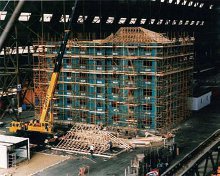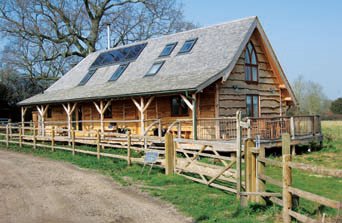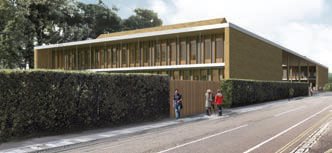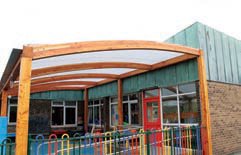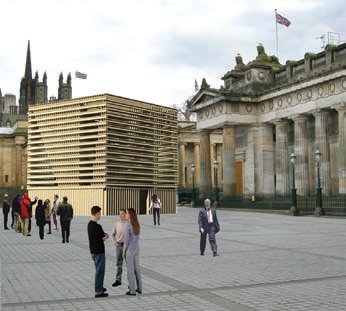Research required
16 June 2014There are plenty of opportunities for UK timber but progress could be stymied by a lack of research. Keren Fallwell reports.
There is a bright future for UK-grown timber in construction but more research - backed by the supply chain - is needed.
This was one of the main issues that ran through the Royal Forestry Society's Building in Wood conference in Warwickshire in May.
"The move towards more timber in construction is inevitable but I'm frustrated that the UK timber industry thinks there's no need to do timber research," said Richard Harris, professor of timber engineering at University of Bath. "They can't be complacent. If they want things to move on they must make sure this research is done."
Interest in tall timber buildings was growing, he said, and the lifting of height limits on timber construction was the result of research, and the TF2000 research in particular. TF2000, a collaboration between BRE, TRADA Technology, the timber industry and the government, involved full-scale testing of a six-storey timber frame building and led to changes in the Building Regulations and the lifting of the four-storey limit on timber frame structures.
"One can't exaggerate the importance of this project," said Professor Harris. "We must remind the industry that it is this project that allows them to build above three storeys and unless they invest in research they are going to find themselves up against limits."
The need for research was also highlighted by keynote speaker Dr Ed Suttie, director of sustainable materials at the BRE, who called for the whole supply chain, from foresters through to the construction industry, to collaborate more.
He described TF2000 as a "groundbreaking moment" that showed the value of research and "how we have to get involved and get behind it".
And research is vital at a time when UK-grown timber is gaining market share and, globally, timber's benefits are being recognised.
The UK's annual timber consumption is now 14 million m3 - set to rise to 15 million m3 by 2020 - and has a value of £8bn. Of that, UKgrown timber accounts for 40% of sawnwood and 53% of panel products and the forestry and timber industries contribute £2bn to the economy.
And there were plenty of opportunities for UK-grown timber, said Dr Suttie. Construction companies were looking for ways to differentiate themselves and to make construction more efficient; businesses could invest in UK forests and woodlands; and UK timber could be promoted on its legality and sustainability.
"We have PEFC and FSC; Grown in Britain is going to link to UKWAS to offer smaller woodlands a route to market; and the EU Timber Regulation plays to the advantage of UK-grown timber," said Dr Suttie.
The UK Contractors Group (UKCG), whose members have a combined buying power of £27bn, is one organisation that has made a commitment to buying British where possible.
"This small tweak in the way we procure will make a big difference to the [timber] industry," said Steve Cook, UKCG chair and principal sustainable development manager at Willmott Dixon Re-Thinking.
It provided value for UKCG members too. "UK timber is a truly sustainable resource; it's a great story to tell our clients and great corporate social responsibility," said Mr Cook. UK timber was ideal for C16 but sometimes struggled to gain market access because C24 was specified - often unnecessarily in Mr Cook's view.
"We're challenging the National Building Specification to try to educate the supply chain and designers about where homegrown C16 may be fit for use and likely to be cheaper," he said. "For example in solid floors a C16 home-grown joist would span 4.6m. A C24 will span just 10in more so we can use C16.
"Also, with increasing insulation, walls are getting thicker which allows lower grade material to be used," he added.
Wood fibre insulation was another opportunity. "It's used a lot in the retrofit sector. It's high value - about £18/m2 - and currently it's all imported," said Mr Cook. There was also potential in solid and engineered flooring, the bulk of which is imported, and for hardwoods there was potential in street furniture, finger-jointed blocks for high-end worktops, door thresholds, decking and cladding.
But identifying products that can be made from UK timber is only one part of the answer; the other is improving the forest resource to meet a wider - and higher value - range of end uses.
As Dr Suttie pointed out, at present 70% of England's woodlands are not managed.
"The challenge is in the type of forestry and material we have. We need to find ways to make woodlands produce material suitable for glulam and CLT," said Jez Ralph of Timber Strategies, adding that, again, innovation and research were key.
Woodland owners are addressing the problem of single-aged stands by converting to more diverse species and diameter classes but more research is needed to find uses for the timber.
Improving the forest resource is the focus of Forest Research's work.
"Timber is a variable resource and various factors affect its growth," said Forest Research's Elspeth Macdonald.
"Understanding these variations enables us to make the best use of the material we have and to grow as much timber for future construction needs as we can."
The organisation's research has identified the conditions for different conifers to produce the optimum construction material.
"We need to select the right species for a site, be realistic about what we can grow where and practise good silviculture; for example you can't grow good quality construction material on a cold, windy site," said Ms Macdonald.
Nick Hoare from Stourhead (Western) Estate advocated improving the growing stock rather than relying on technology to improve the finished product.
"Yes, you can take poor quality timber, cut the defects out and finger-joint it but a bit of timber without a knot is better than a piece with a knot that someone has to do some work with," he said.
He opted for continuous forest cover - rather than clear felling - thinning and pruning. "I don't know what's going to happen in the future but I might as well grow the best I can," he said.
Ben Law of the Roundwood Timber Framing Company has made a living out of the poorer quality timber from UK woodlands by using it for round pole construction.
In southern England there are about 17,000ha of sweet chestnut - much of it neglected and that which is managed goes to fencing, selling for around £24 for a 250mm stem. Mr Law will pay £65 because he turns them into high-value buildings.
When he built his first house 12 years ago it featured on Channel 4's Grand Designs where it won Kevin McCloud's and the public's vote for their favourite project.
"Surely that's what we need to look at [public opinion] if we're going to market timber in the building industry," said Mr Law. "There's a degree of rustic charm which perhaps is where the lower value timber can be used a lot more."
The company uses a variety of UK wood - European larch, Douglas fir, Lawsons cypress, ash - and in the majority of projects it is sourced within a 10-mile radius of the site.
Poles are used for the structure and sawn timber for other elements such as cladding, shakes and shingles and flooring. The latter is dried and machined by a local sawmill and clients who value the story behind it will often pay more for it than for flooring imported from Europe.
"We have clients who pay more for 'bad' flooring than 'good' flooring because they want the knots," said Mr Law. "I can also take them to the forest and show them how it's helping the management of a local woodland."
Mr Law made a plea to architects to change their approach.
"We need them to think resource first and design second so they're looking at the local available resource and we need to reduce timber miles. We also need to be creative and imaginative with what we have. If you have a curved pole, think how you can use it rather than chop it up for firewood."
Peter Wilson, director of the Wood Studio in Edinburgh Napier University's Institute for Sustainable Construction, also urged a greater understanding among architects and engineers.
"You can't use natural materials unless you understand them. Timber is not taught well in schools of engineering and architecture.
We need to change that," he said. There was also a need to think of timber not just for rural and domestic buildings but large structures, such as the new Canary Wharf Crossrail station, and structures to fill public spaces, such as AHEC's red oak Timber Wave and cross-laminated tulipwood Endless Stair, both London Design Festival projects.
A more everyday product - I-joists - are used in Graeme Massie Architects' design for a pavilion for the Edinburgh Arts Festival.
The structure - the size of a three-bedroom house - would be sited on the prominent location of the Mound between the Royal Scottish Academy and the National Gallery of Scotland.
"If we think about wood as a domestic construction material we are not going anywhere," said Mr Wilson. "We need to think big; we need to think how we view the futures of cities and how we construct them because the old ways don't work anymore in terms of carbon and energy issues. We need to think differently and timber offers us that opportunity."
Local enterprise
Using Corsican pine in its new Enterprise Centre has thrown up some challenges for the University of East Anglia but it hopes it will pave the way for greater use of locally-grown timber.
The Corsican pine, sourced from Thetford Forest on the Suffolk/Norfolk border, will be used in panels in one wing of the two-storey E-shaped building. The main structure will be CLT from Austria.
Ben Binns of the university's Centre for the Building Environment said using large-scale timber frame from local sources raised the cost because there was no supply chain for that volume.
"Housing associations say they would like to use local timber, merchants say they would source it if they could, but nobody will dip their toe in the market," said Mr Binns.
There were also grading and drying issues. The timber was graded visually because there is no Corsican pine grading machine in the UK or Ireland, and the timber had to be sent to Ireland for drying as the local mill didn't have the capacity.
"It added carbon but you have to start somewhere," said Mr Binns.
Despite the hurdles, he said it was a "great story to show that you can use local timber".
Glulam challenges
Buckland Timber was established in 2012 to manufacture glulam from UK timber but grading and kilning issues and economies of scale mean at present it is using largely Scandinavian spruce and Siberian larch.
"To produce glulam competitively with imports it has to be an efficient process," said director Robin Nicholson. "It has to be sawn, full loads and to the right moisture content."
Recently the company has been focusing on UK larch, anticipating increased supply because of Phytophthera, and has had success in pressure treating the species, but again it has faced supply issues.
"We need a sawmill willing to saw larch and also we can't get it delivered to us at the right moisture content of 12%," said Mr Nicholson. "To achieve the right moisture content we'll probably have to air dry it and then kiln dry it."
However, Buckland is not bowed by the obstacles.
"We set out to use locally-grown timber and we are not going to give up too easily," said Mr Nicholson.
